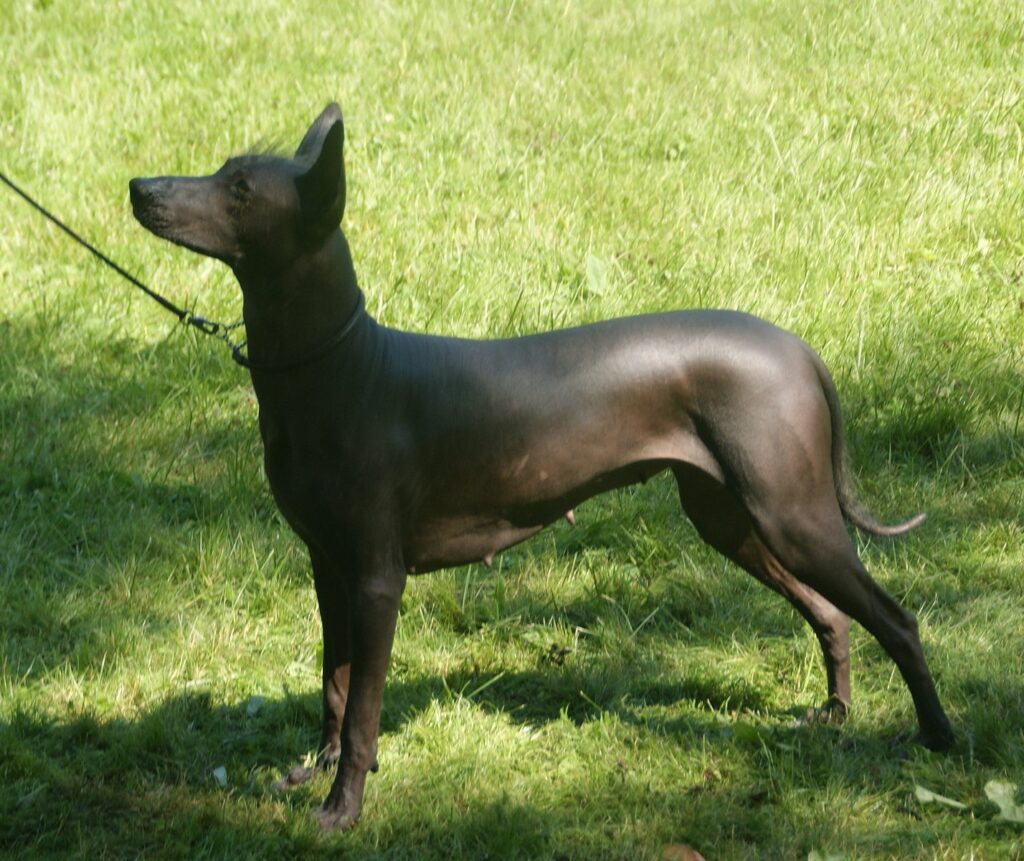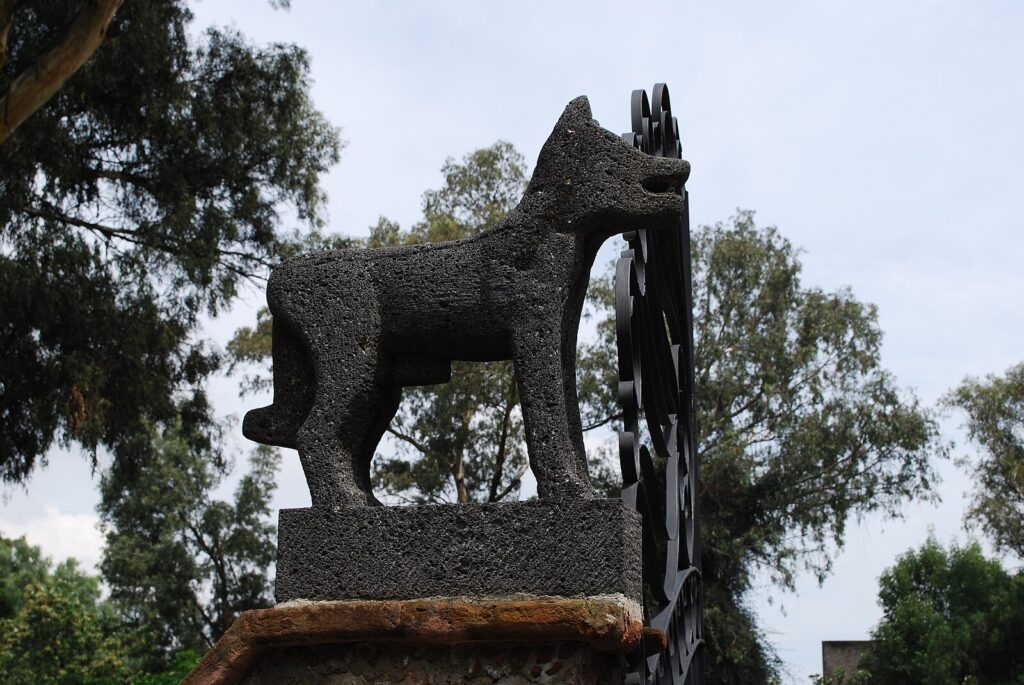The Xoloitzcuintli, better known as a Xolo dog, is an ancient breed that has existed for over three thousand years. Still popular in modern Mexico, this hairless dog takes its name from the Aztec god Xolotl.

Xolotl
Xolotl was an important Aztec god who guided souls – and the sun – through the underworld. He was associated with deformities, misfortune, sickness, monsters, fire, and twilight. The Mexica people believed him to be a personification of the planet Venus.
Xolotl had the power to enter and exit the underworld at whim. He was also capable of transforming himself into maize or a salamander.
The axolotl is a rare salamander endemic to central Mexico that’s forever stuck in adolescence. It bears the external gills that most species lose when they grow to adulthood. Its name means ‘water dog’.
The god Xolotl was most often depicted as a man with the head of a dog. This is a strange parallel with the Egyptian god of the underworld, Anubis. He was also depicted as a skeleton or a deformed monster with backwards feet.
Quetzalcoatl was the god of life and light, lord of the day. Xolotl was his twin, responsible for guiding the sun through the underworld each night so that it may rise again each morning.
In ancient times, it was common practice to kill one twin each time a pair was born. Quetzalcoatl represents the surviving twin, and Xolotl is the twin who was sacrificed to the darkness.
Although he is known as an Aztec god, Xolotl’s history stretches back even further. Maya codices depict him as the dog that brought fire to mankind. He was associated with death and lightning.
In some myths, the twin gods descended into the underworld together to collect the bones of the dead. Quetzalcoatl then mixed these bones with his own blood to create humankind.
In old Mexican stories, departed souls had to travel through eight levels of the underworld before reaching their final resting place. This journey was said to take four years and perilous trials, including swimming across an enormous river inhabited by a giant iguana.
No soul could make it across without the help of a Xoloitzcuintli.
Xoloitzcuintli
The name Xoloitzcuintli simply means Xolotl dog, itzcuīntli being the word for dog in the Aztec language Nahuatl.
Due to their association with the god of the underworld, Xolo dogs were sometimes sacrificed in ancient times to guide their owners through the underworld.
This practice predates the Aztec civilization. Xolo dogs have been found in both Mayan and Toltec tombs. Ceramic statues in the shape of these dogs have been found in tombs over two thousand years old. Even the people of Chupícuaro buried dogs with their dead as early as 800 BC.
Xoloitzcuintlis were often used as hunting dogs. They were also guard dogs, a role that was often more symbolic than literal. They watched over their families both in life and in death. These beloved companions were also allowed in bed with the sick to keep them warm.
When the Spanish arrived in the sixteenth century, they observed Xolo dogs being served alongside turkeys at great banquets. They were a minor part of the Aztec diet, however. Over ninety percent of their meat came from wild deer.
Xolos were not an everyday food. They were sacred animals believed to impart mystical powers and ward off even spirits. The Spanish had no such beliefs. They capitalized on the easy source of meat and nearly ate the Xolo to extinction.
Small groups of Xolo dogs survived in rural areas, and some indigenous people still kept them as pets. The breed experienced a resurgence after the Mexican Revolution in 1910 and became more and more popular. They were declared a Mexico City icon in 2016.

Modern Xolo Dogs
Modern Xolo dogs are not identical to their pre-Columbian counterparts.
Modern genetic analysis has shown that, while Xolo dogs and Chihuahua are descended from pre-colonial ancestors, those dogs interbred with and were more or less eclipsed by dogs brought over from Europe. Geneticists believe that less than five percent of their ancestry can be traced back to their ancestors that lived alongside the Aztecs.
Even so, the identifying traits of the breed have been maintained over the centuries through careful selection. A hundred years ago they were still quite rare, but a resurgence of interest revived the breed in Mexico through careful efforts in the early twentieth century.
Frida Kahlo and Diego Rivera were two of the first people to support the resurgence of this ancient breed. Rivera started the first modern breeding kennel for Xolo dogs. They appear in Kahlo’s self portraits and also in many photographs of her and her husband. Rivera included them in some of his famous murals as well.
Today, xolo dogs have become an icon that represents Mexican identity. They’re a common sight in pueblos and cities throughout Mexico. They’re particularly popular in November, when some owners paint them to look like skeletons for Dia de Muertos.
The Xoloitzcuintli is frequently depicted in popular culture in both Mexico and the United States. In the Pixar movie Coco, a Xolo dog accompanies the protagonist through the world of the dead.
His tongue lolls to one side of his mouth. Like modern Xolos and their ancient ancestors, the lack of premolar teeth means that the pink tongue often escapes out one side.
The Xoloitzcuintli was formally recognized by the American Kennel Club in 2011. The AKC recognizes three sizes: toy, miniature, and standard. Standard Xoloitzcuintlis weigh between 30 and 55 pounds. They allow both hairless and smooth-coated variants.
The gene which makes Xolo dogs hairless is dominant. It’s common for litters to contain a mix of hairless puppies and pups with fur. The skin of the hairless dogs is usually black or dark gray.
Xolo dogs are highly affectionate, loyal companions. They’re generally easy to train, being both intelligent and eager to please. These energetic, playful dogs are happiest with plenty of exercise and mental stimulation, but their overall temperament is quite calm.

